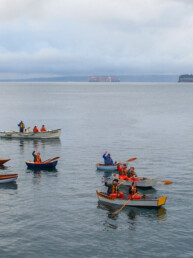One of the mistakes parents, like me, make these days is to overinflate our perception of influence with our children and their interests. As boat folk, deeply held hopes that our children will love time on the water can shift away from encouragement and exposure to boating and toward more heavy-handed pressure—so often ensuring the opposite of the desired outcome.
I’m no parenting expert (is there really such a thing?), but as someone privileged enough to have just welcomed his second child this spring, I think about stuff like this quite a lot. I also spent some time this month on the periphery of the Race to Alaska circus, and was floored by the number of young teams involved—two teams made up entirely of teenagers (both skippered by girls!), as well as a team of 20 year olds (two of whom have already finished at least one R2AK), and a young woman in her early 20s making the run to Ketchikan solo on a Hobie Tandem Island (a sailing kayak with outriggers). These kids’ parents must be so damn proud and, I assume, holding their breath too—all these teams are still out on the course at the time this magazine goes to press.
I don’t know these young sailors very well, and no, I can’t give you the common thread that all of these kids share, other than their spirit of adventure and skills to make it safely and successfully. But it certainly leaves me reflecting on how they got there.
As is so often the case with sailors who impress me, these young people seem to possess a special combination of competence and confidence. One take on the genesis of these attributes can be found in this month’s Youth Sailing Beat column (page 24), in which Solvig Sayre shares a detailed example of how skills facilitate fun and freedom for young sailors, and that confidence in those skills is central to enjoyment.
Having only experienced non-competitive sailing in my own childhood, I look back on my early sailing days as an exercise entirely in fun (and ok, occasionally, fear). However, since a lot of that background was sailing scows at a summer camp, there were clear pathways for skill progressions already in place, and success at each level gave access to more ways to go sailing and have fun doing it. To me, that’s where this notion really takes flight—that the ember of desire is given oxygen by skills, a clear and effective path to advance provides fuel, and fun is the warmth of that fire, ever-present but burning ever-hotter.
I am certain that not one of these young sailors was told to do Race to Alaska by a parent. It’s not as if they didn’t have help along the way, but the desire and decision to go, the preparation of the boat and themselves—it’s ultimately their own and that’s the only way it works. There’s not a youth sailing program in the world teaching kids to race engineless boats for a week-plus through such challenging and unforgiving waterways. And yet there they are. How inspiring is that?
And that’s where all of this leaves me. My love of sailing, alone, is not directly transferable to my children. I appreciate that helping my kids be exposed to boats and boat-folk and boat life can lay crucial groundwork. But when I think about fanning the flames of the passion I hope they have, I’ll think about how to help them chase the competence that breeds confidence, and to dream big, fun dreams. One last note—these R2AK teams are made up of friends. To whatever extent skills are the foundation on which fun and freedom and opportunity can be built, community and camaraderie are what make that house a home.
I’ll see you on the water,
Joe
Joe Cline
Joe Cline has been the Managing Editor of 48° North since 2014. From his career to his volunteer leadership in the marine industry, from racing sailboats large and small to his discovery of Pacific Northwest cruising —Joe is as sail-smitten as they come. Joe and his wife, Kaylin, have welcomed a couple of beautiful kiddos in the last few years, and he is enjoying fatherhood while still finding time to make a little music and even occasionally go sailing.






